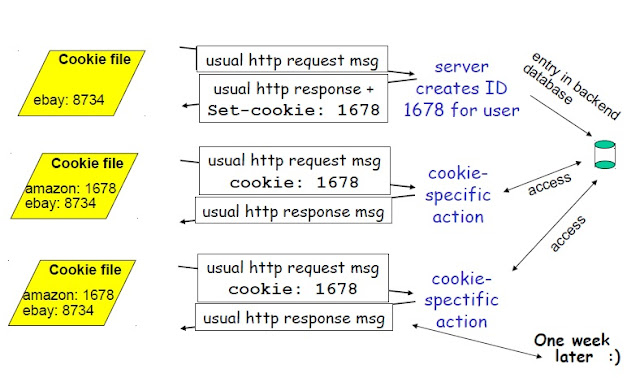Ethernet
Ethernet is a standard communications protocol
embedded in software and hardware devices,
intended for building a local area network (LAN)
Ethernet is a contention media access method that
allows all hosts on a network to share the same bandwidth of a
link.
Ethernet is popular because it’s readily scalable,
meaning it’s comparatively easy to integrate new
technologies, such as FastEthernet and Gigabit Ethernet, into
an existing network infrastructure.
Ethernet defines the lower two layers of the OSI Reference
Model
The IEEE divides the data link layer into two sub-layers, the
logical link control (LLC) layer and the media access control
(MAC) layer The MAC layer varies for different network types
and is defined by standards IEEE 802.3 through IEEE 802.5
IEEE 802.3 to ISO
 |
| IEEE 802.3 to ISO |
Ethernet's Logical Relationship to the ISO Reference Model
Ethernet Network Topologies and Structures
Ethernet uses a bus or star topology and supports
data transfer rates of 10/100/1000 Mbps
 |
| Ethernet Network Topologies and | Structures |
Ethernet networking uses Carrier Sense Multiple Access with
Collision Detection (CSMA/CD), a protocol that helps devices
share the bandwidth evenly without having two devices
transmit at the same time on the network medium.
CSMA/CD
Network access regulated by the CSMA/CD procedure:
Carrier Sense = “listen” to the cable
Multiple Access = all stations can send at the same time
• Collision Detect = collisions must be recognized
MAC Types
There are two Media Access Control(MAC)
protocols defined for Ethernet:
- Half-Duplex
- Full-Duplex
Half-Duplex
Refers to the transmission of data in just one
direction at a time
Half-Duplex Ethernet is the traditional form of
Ethernet that uses the CSMA/CD
Carrier Sense Multiple Access Collision Detect(Half-Duplex)
The network is monitored for presence of a transmitting
station (carrier sense)
Adapter does not transmit if it senses that some other
adapter is transmitting
The transmission is delayed if an active carrier is detected
The station continues to monitor the network until the carrier
stops
If an active carrier is not detected, then the station
immediately begins transmission
While the transmitting station is sending the frame, it
monitors the medium for a collision.
If a collision is detected, the transmitting station stops
sending the frame data
Before attempting a retransmission, adapter waits a
random time, that is, random access
If repeated collisions occur, then transmission
is repeated
But the random delay is increased with each
Attempt
This process repeats until a station transmits a
frame without collision
State Diagram for CSMA/CD
 |
| State Diagram for CSMA/CD |
Full-Duplex
Based on the IEEE 802.3x standard, “Full- Duplex” MAC
type bypasses the CSMA/CD protocol
Full-duplex mode allows two stations to simultaneously
exchange data over a point to point link
The aggregate throughput of the link is effectively
doubled
A full-Duplex 100 Mb/s station provides 200
Mb/s of bandwidth
Use of Full-duplex Ethernet
Full-duplex Ethernet can be used in three situations:
- With a connection from a switch to a host
- With a connection from a switch to a switch
- With a connection from a host to a host using a
crossover cable
Ethernet at the Physical Layer
Ethernet was first implemented by a group called DIX
(Digital, Intel, and Xerox).
They created and implemented the first Ethernet LAN
specification, which the IEEE used to create the IEEE
802.3 Committee.
This was a 10Mbps network that ran on coax, and then
eventually twisted-pair, and fiber physical media.
Ethernet (IEEE802.3) Frames
 |
| Ethernet (IEEE802.3) Frames |
Preamble
- A sequences of 64 bits used for synchronization
- Detects the presence of a signal
- Begin reading the signal before the frame data
arrives
Destination & Source MAC Addresses
– The Destination MAC Address field identifies
the station or stations that are to receive the
Frame
– The Source MAC Address identifies the station
that originated the frame
Length
- Specifies the length of packet
MAC Client Data
- Contains the data transferred from the source
station to the destination station or stations
Frame Check Sequence
– Contains a 4-byte cyclical redundancy check
(CRC) value used for error checking
Cyclical Redundancy Check
The CRC method operates on blocks of data called
frames.
Basically, the sender appends a bit sequence to every
frame, called the FCS (frame check sequence).
The resulting frame is exactly divisible by a predetermined
number.
The receiving computer divides the frame by the
predetermined number.
If there is a remainder, the frame is considered corrupted
and a retransmission is requested.
Ether net Standards
IEEE 802.1: Standards related to network management
IEEE 802.2: General standard for the data link layer in
the OSI Reference Model
– The IEEE divides this layer into two sublayers
- Logical link control (LLC) layer
- Media Access Control (MAC) layer
– The MAC layer varies for different network types and
is defined by standards IEEE 802.3 through IEEE 802.5
IEEE 802.3: Defines the MAC layer for bus networks that use
CSMA/CD. This is the basis of the Ethernet
Standard IEEE 802.4: Defines the MAC layer for bus
networks that use a token-passing mechanism
(token bus networks)
IEEE 802.5: Defines the MAC layer for token-ring networks
IEEE 802.6: Standard for Metropolitan Area
Networks (MANs)















